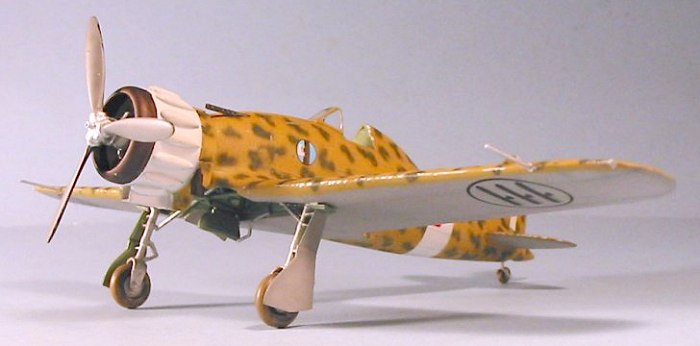
Pacific Coast Hobbies 1/48 MC.200
|
KIT # |
? |
|
PRICE: |
$42.95 from Pacific Coast Models |
|
DECALS: |
six options |
|
REVIEWER: |
Tom Cleaver |
|
NOTES: |
Short run with resin parts |

|
HISTORY |
During the Second World War, Italian aircraft were subjected to distorted propaganda that played on the fact the Italians were using aircraft that did not look as aerodynamically advanced as did the aircraft being used by the Allies. The Italian air industry was hobbled by older production techniques, and by the need to meet design specifications issued by an overly-conservative Regia Aeronautica, and to cater to the extreme conservatism of Italian combat pilots when it came to such questions as the supremacy of the monoplane over the biplane, the need for enclosed cockpits, the need for a heavy armament, and other things considered de rigeur in the aeronautical state of the art. It didn't help that the Italian aircraft industry had nothing like the Merlin or Daimler-Benz series of in-line engines, or the high-powered radials created by Pratt & Whitney.
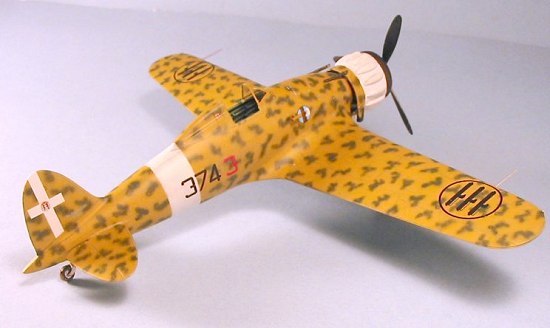 That said,
just about everything anyone "knows" about Italian aircraft from reading
non-Italian sources is false, due to the "hang-over" created by Second
World War propaganda.
That said,
just about everything anyone "knows" about Italian aircraft from reading
non-Italian sources is false, due to the "hang-over" created by Second
World War propaganda.
A prime example of this is the Macchi-Castoldi series of fighters, and particularly the progenitor of the series, the C.200 Saetta (which can be translated as both Lightning Bolt or Arrow - the weapons of Jupiter).
The Castoldi fighters had a similar background and pedigree to that of Reginald J. Mitchell's Spitfire, since Mario Castoldi was his sharpest competitor in the creation of high speed seaplanes for the Schneider Cup Trophy competition that lasted from 1920 to 1931. Castoldi's racers had been top competitors, with the M.39 winning the 1926 Schneider competition, and the M.C.72 going on in 1933 to beat the record of the Supermarine S.6B by setting a world air speed record of 423.82 m.p.h. Unfortunately, the problems in engine development that had kept the M.c.72 from beating the S.6B to win the Schneider Cup outright would also dog the development of Castoldi's fighters.
The Schneider influence on the C.200 was not so apparent upon its rollout, since the best engine the Italians had available was the Fiat A.74 R.C.38, a magnificent powerplant derived from Gnome-Rhone designs, but capable of only 870 h.p. Another stumbling block was the insistence of the Air Force that the best possible field of view for the pilot was paramount before aerodynamic cleanliness. The result was an airplane with a bulky, drag-producing radial in a poorly-designed cowling, matched to a humped-back fuselage that completely eradicated all evidence of the fighter's racer lineage.
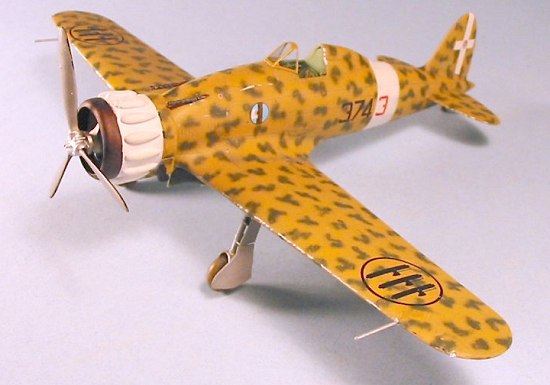 Flight trials
following first flight on December 24, 1937, revealed the C.200 was
singularly maneuverable, with exceptionally well-harmonized controls and
no vices. One remarkable bit of aerodynamic sleight of hand was the
asymmetric wing, in which the left wing was longer than the right, which
effectively cancelled engine torque and added to the airplane's
maneuverability. Like all other Italian fighters, it was lightly armed
in comparison with its contemporaries, carrying only two .50 caliber
machine guns with 370 rounds per gun.
Flight trials
following first flight on December 24, 1937, revealed the C.200 was
singularly maneuverable, with exceptionally well-harmonized controls and
no vices. One remarkable bit of aerodynamic sleight of hand was the
asymmetric wing, in which the left wing was longer than the right, which
effectively cancelled engine torque and added to the airplane's
maneuverability. Like all other Italian fighters, it was lightly armed
in comparison with its contemporaries, carrying only two .50 caliber
machine guns with 370 rounds per gun.
The conservative pilots of the Italian fighter arm disliked the enclosed cockpit's sliding canopy. The C.R.42-equipped 4 Stormo refused to take the first C.200s because the monoplane - as maneuverable as it was - was less so than their biplanes. The pilots of 1 Stormo, who had flown the C.R.32 in the Spanish Civil War, were most anxious to convert to the C.200 since their experiences over Spain had convinced them the day of the biplane was over.
The C.200 did not see combat until June 1940, when the aircraft of the 6 Gruppo Autonomo in Sicily, which were detailed to provide escort to S.79 Sparvieros bombing Malta. When faced by the Hawker Hurricane, it was shown that while they were both of similar performance, the C.200 had a considerably better climb rate and could out-turn and out-dive the British fighter, as well as having an equal ability to absorb punishment. In March 1941, Saettas of the 150 Gruppo entered combat over Greece while the C.200s of the 374 Squadriglia arrived in Libya, followed shortly by the similarly-equipped 153 Gruppo. That summer, the Corpo di Spedizio Italiano was formed for operations in the Soviet Union, with a fighter element equipped with 59 Saettas of the 22 Gruppo.
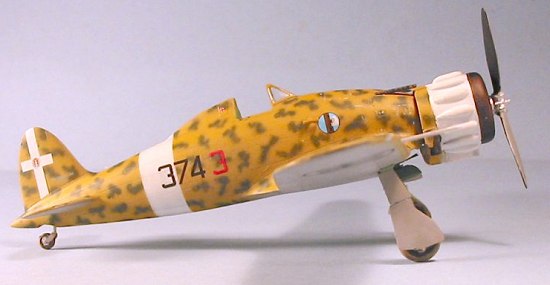 While Allied
propaganda made fun of the way the C.200 looked, Allied fighter pilots
found it a worthy opponent in the hands of a skilled pilot, and accorded
it respect. A standard C.200 weighing 5,121 pounds attained a maximum
speed of 312 mph at 14,759 ft., while an altitude of 3,280 ft. was
attained in 1 minute, 3 seconds, a very creditable climb performance.
Service ceiling was 29,200 feet, and normal range was 354 miles.
While Allied
propaganda made fun of the way the C.200 looked, Allied fighter pilots
found it a worthy opponent in the hands of a skilled pilot, and accorded
it respect. A standard C.200 weighing 5,121 pounds attained a maximum
speed of 312 mph at 14,759 ft., while an altitude of 3,280 ft. was
attained in 1 minute, 3 seconds, a very creditable climb performance.
Service ceiling was 29,200 feet, and normal range was 354 miles.
By 1941, the C.202, powered by a German Daimler-Benz D.B.601 engine that allowed Mario Castoldi to restore the symmetry of line associated with his racers, and with an appreciably higher performance, began rolling off the production line. Sharing 80 percent commonality with the earlier C.200, the two fighters were produced simultaneously through 1942, due to a lack of engines for the C.202, with the C.200 assuming tactical duties as a fighter bomber and ground strafer while the C.202 undertook the air superiority mission.
C.200s were among the Italian fighters that joined the Co-Belligerent Air Force after the Italian surrender in September 1943, and the airplane served to the end of the war.
|
THE KIT |
There have been two other C.200s available for modelers in 1/48. One, by Classic Airframes, was not one of the better kits released by this company, with some severe outline difficulties. The Italian company Astrokit released an all-resin C.200 in 1995, which is still available and makes up into a very acceptable model, though the fuselage is a bit narrow when compared with the more accurate Hasegawa C.202 and C.205 kits. In 1/72, I am aware of only one kit of the C.200, a 1960s release from Revell which - if memory serves - did make up into an acceptable-looking model.
This kit from
Ken Lawrence's Pacific Coast Hobbies is a testament to the fact that
"anybody who knows me knows you don't tell me 'you can't do that,'" as
Ken explains. PCH is known as the leading distributor of quality resin
and multi-media kits of Italian aircraft, and the C.200 had long been one
of Ken's favorites. As with many others, he fully expected Hasegawa
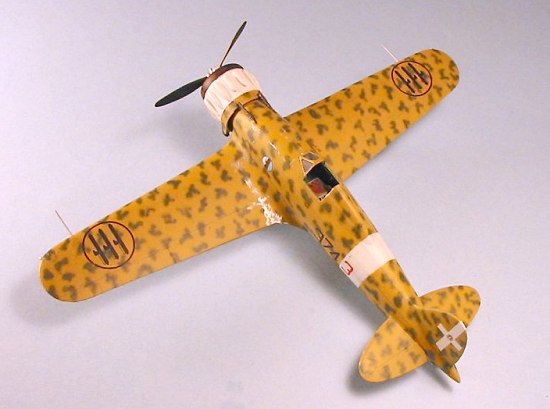 to round out their
mid-90s releases of the C.202 and C.205 with a C.200; when that didn't
happen, he investigated the possibility of working with Hasegawa to
create a hybrid kit of the C.200 based on their C.202. That fell
through, with the result being that Ken went to Italian aircraft expert
Maurizio di Terlizzi and got a kit designed that he could have
produced by MPM under contract, with resin detail parts by another
Italian company and decals printed by Cartograph, with photo-etch detail
parts by Eduard. "The deal was, Massimo had to approve the final design
of the kit, and until he was satisfied it wasn't ready to go into
production." This resulted in the kit being release 18 months late, but
a quick look in the box shows the time was not wasted.
to round out their
mid-90s releases of the C.202 and C.205 with a C.200; when that didn't
happen, he investigated the possibility of working with Hasegawa to
create a hybrid kit of the C.200 based on their C.202. That fell
through, with the result being that Ken went to Italian aircraft expert
Maurizio di Terlizzi and got a kit designed that he could have
produced by MPM under contract, with resin detail parts by another
Italian company and decals printed by Cartograph, with photo-etch detail
parts by Eduard. "The deal was, Massimo had to approve the final design
of the kit, and until he was satisfied it wasn't ready to go into
production." This resulted in the kit being release 18 months late, but
a quick look in the box shows the time was not wasted.
The injection-molded parts for the airframe are by MPM and are among the best work they have done on any kit to date. The resin detail for the cockpit and engine is superb, but what really blows things away is the fully-hollow single-casting of the cowling with all its bulges and shape changes. It is thin, and perfectly cast, looking better than any other attempt by any other model company to get the most obvious component of the C.200 "right." The vacuform canopy allows the modeler to create that version of the Saetta with the folding side flaps, though one can also cut them off to make the earlier production version.
The decals are beautiful, providing two different versions of the fasces national insignia, and all other markings for six different C.200s in the four different camouflage patterns used on the airplane.
One thing has to be specially pointed out, and that is the instruction sheet. This is obviously a sheet drawn and written by someone who actually sat down and assembled the kit! Not only that, but there is a separate sheet with much greater detail for the modeler who chooses to equip the model with the finer detail available from the photo-etch parts. Too often, instruction sheets for limited-run kits are either useless or confusing (or both) - PCH is to be congratulated for their effort here.
|
CONSTRUCTION |
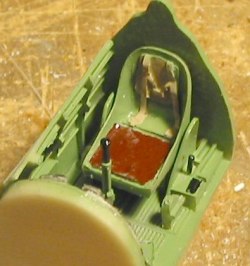 This kit is as
close to a Tamigawa "slammer" as a limited-run kit gets. The parts are
mostly flash free and easily cleaned up. It's important to cut off the
mold-release pins on the interior surfaces of the wings and fuselage and
horizontal stabilizers, but there is no difficulty with that. I
proceeded to assemble the fuselage, with the horizontal stabilizers, as
one sub-assembly, while assembling the wing as another sub-assembly.
This kit is as
close to a Tamigawa "slammer" as a limited-run kit gets. The parts are
mostly flash free and easily cleaned up. It's important to cut off the
mold-release pins on the interior surfaces of the wings and fuselage and
horizontal stabilizers, but there is no difficulty with that. I
proceeded to assemble the fuselage, with the horizontal stabilizers, as
one sub-assembly, while assembling the wing as another sub-assembly.
I then painted
and detailed the resin cockpit parts per the kit instructions, and
assembled them. The cockpit popped easily into place inside the fuselage
and was fixed in position with CA glue.
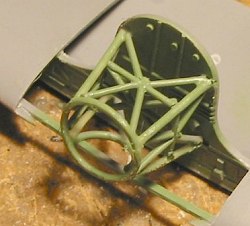
I then
attached the engine mount assembly to the firewall which is part of the
wing assembly. These parts showed some warpage and this was the only
part of the assembly that was "fiddly." Once everything was in place the
wing sub assembly fit easily to the fuselage. Overall I only needed Mr.
Surfacer 500 on the fuselage centerline seam and the wing-fuselage
joints. These areas disappeared under a coat of Mr. Surfacer accompanied
with a few minutes of sanding once it had dried.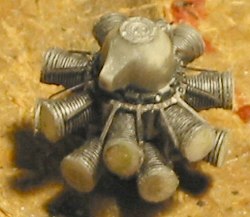
I assembled the engine after painting the component parts with various shades of Metalizer paints. The engine has separate cylinders, but is again well-designed and goes together without problem.
I cut the cowling off its molding block, and then cleaned up the too-thick interior at the rear of the cowling with my Dremel Tool. Be careful here not to get it too thin or it will break under handling. I had to test fit and sand the heads of the engine cylinders to enable the engine to finally slide into position inside the cowling, then attached this sub assembly to the rest of the model.
|
COLORS AND MARKINGS |
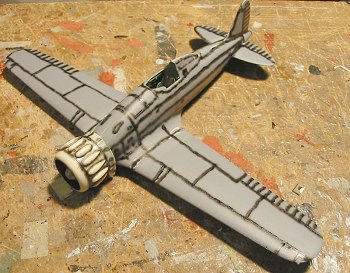 Painting:
Painting:
After pre-shading the model with flat black airbrushed along the panel lines, I painted the cowling white and the area of the fuselage stripe to the rear white. These were masked, and the lower surfaces were painted with Tamiya "Sky Grey." The upper surface was painted with a mixture of Gunze-Sangyo "RLM79 Sandy Brown" and Gunze "British Mid Stone", suitably "sun bleached" with succeeding applications of lighter coats, then the blotches were airbrushed using Gunze-Sangyo "RLM71 Dark Green." I unmasked everything, touched up a couple spots on the white stripes, then painted the exhaust collector ring and exhaust pipes with Metalizer "Burnt Iron." After a coat of Future, the model was ready to proceed for decaling.
Decals:
I chose to do the option of 374 Squadriglia, the first Regia Aeronautica unit to enter combat over North Africa, mostly by a process of elimination of not wanting this model to have a similar camouflage paint to my other C.200 or my C.202 models. The decals were easy to work with and went down without problem under a coat of Micro-Sol.
|
FINAL ASSEMBLY |
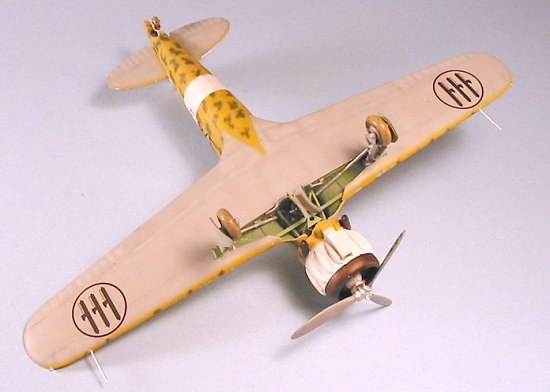 After washing
off decal setting solution residue, the model received another coat of
Future. I then assembled the landing gear and attached the prop. There
is a missing part in the kit - a disc that goes right behind the prop and
mates to the nose of the engine crank case. I scratched this from some
Evergreen sheet. I then applied three coats of thinned Dullcote to get a
very flat final finish. I decided to do a "mid-production airplane as
one of the first that was sent to North Africa without the canopy side
flaps, since this allows the viewer to see the very nice cockpit more
easily.
After washing
off decal setting solution residue, the model received another coat of
Future. I then assembled the landing gear and attached the prop. There
is a missing part in the kit - a disc that goes right behind the prop and
mates to the nose of the engine crank case. I scratched this from some
Evergreen sheet. I then applied three coats of thinned Dullcote to get a
very flat final finish. I decided to do a "mid-production airplane as
one of the first that was sent to North Africa without the canopy side
flaps, since this allows the viewer to see the very nice cockpit more
easily.
|
CONCLUSIONS |
I say the C.200 is a "funky-looking but cool" airplane - several friends of mine swear it is "downright ugly." Whichever, the C.200 was an important piece of equipment in the Regia Aeronautica during World War II, and as such is deserving of a place in any collection of significant Italian aircraft of that conflict. The model itself is easily the equal of the Hasegawa C.202 and C.205, when it is viewed next to its two "mainstream" design comrades.
December 2003
Thanks to Pacific Coast Hobbies for the review sample.
If you would like your product reviewed fairly and fairly quickly, please contact the editor or see other details in the Note to Contributors.